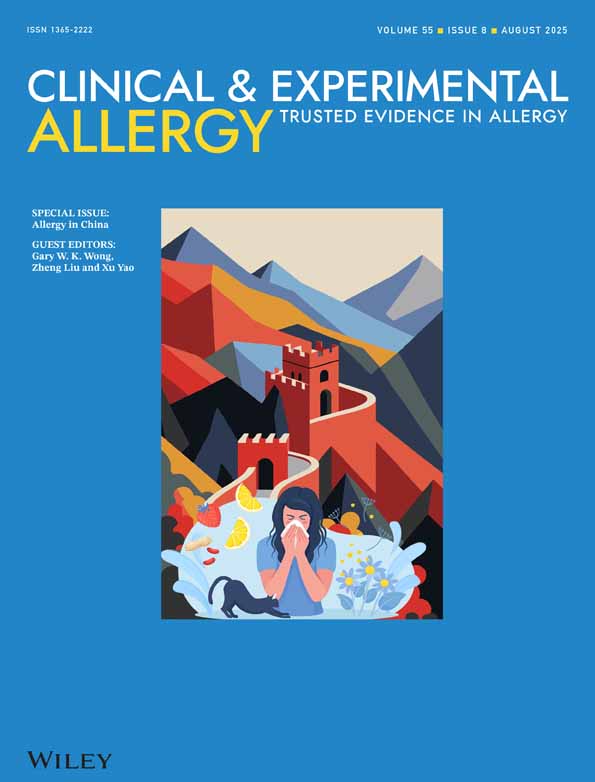The danger of ‘yellow dyes’ (tartrazine) to allergic subjects
Corresponding Author
I. NEUMAN
Pediatric Allergy Unit, Pediatric Department and Laboratory, and Clinical Laboratories, Hasharon Hospital, Petah-Tiqva, Israel
Dr I. Neuman, Pediatric Allergy Unit, Hasharon Hospital, Petah-Tiqva, Israel.Search for more papers by this authorR. ELIAN
Pediatric Allergy Unit, Pediatric Department and Laboratory, and Clinical Laboratories, Hasharon Hospital, Petah-Tiqva, Israel
Search for more papers by this authorH. NAHUM
Pediatric Allergy Unit, Pediatric Department and Laboratory, and Clinical Laboratories, Hasharon Hospital, Petah-Tiqva, Israel
Search for more papers by this authorP. SHAKED
Pediatric Allergy Unit, Pediatric Department and Laboratory, and Clinical Laboratories, Hasharon Hospital, Petah-Tiqva, Israel
Search for more papers by this authorD. CRETER
Pediatric Allergy Unit, Pediatric Department and Laboratory, and Clinical Laboratories, Hasharon Hospital, Petah-Tiqva, Israel
Search for more papers by this authorCorresponding Author
I. NEUMAN
Pediatric Allergy Unit, Pediatric Department and Laboratory, and Clinical Laboratories, Hasharon Hospital, Petah-Tiqva, Israel
Dr I. Neuman, Pediatric Allergy Unit, Hasharon Hospital, Petah-Tiqva, Israel.Search for more papers by this authorR. ELIAN
Pediatric Allergy Unit, Pediatric Department and Laboratory, and Clinical Laboratories, Hasharon Hospital, Petah-Tiqva, Israel
Search for more papers by this authorH. NAHUM
Pediatric Allergy Unit, Pediatric Department and Laboratory, and Clinical Laboratories, Hasharon Hospital, Petah-Tiqva, Israel
Search for more papers by this authorP. SHAKED
Pediatric Allergy Unit, Pediatric Department and Laboratory, and Clinical Laboratories, Hasharon Hospital, Petah-Tiqva, Israel
Search for more papers by this authorD. CRETER
Pediatric Allergy Unit, Pediatric Department and Laboratory, and Clinical Laboratories, Hasharon Hospital, Petah-Tiqva, Israel
Search for more papers by this authorSummary
Oral administration of 50 mg tartrazine to 122 patients with a variety of allergic disorders caused the following reactions: general weakness, heatwaves, palpitations, blurred vision, rhinorrhoea, feeling of suffocation, pruritus and urticaria.
There was activation of the fibrinolytic pathway as shown by reduction of plas-minogen with high pre-kallikrein and low kallikrein values. Reduction in complement activity (CH50) was seen in three out of sixteen reactions.
References
- Barkin, G.D. & McGorern, J.P. (1966) Allergy statistics. Annals of Allergy, 24, 602.
- Bell, I.R. (1975) A kinin model of mediation of food and chemical sensitivities: biobehavioral implications. Annals of Allergy, 35, 206.
- Buswell, R.S. & Lefkowitz, M.S. (1976) Oral bronchodilators containing tartrazine. Journal of the American Medical Association, 235, 1111.
- Colman, R.W., Mason, J.W. & Sherry, S. (1969) The kallikreinogen-kallikrein enzyme system of human plasma. Assay of components and observations in disease states. Annals of Internal Medicine, 71, 763.
- Dacie, J.V. & Lewis, S.M. (1970) Practical Haematology, 4th edn, p. 263. Churchill, London .
- Gerrard, J.W., Ko, C.G., Vickers, P. & Gerrard, C.D. (1976) The familial incidence of allergic disease. Annals of Allergy, 36, 10.
- Godfrey, R.C. & Griffiths, M. (1976) The prevalence of immediate positive skin tests to Dermatophagoides pteronyssinus and grass pollen in schoolchildren. Clinical Allergy, 6, 79.
- Lockey, S.D. (1959) Allergic reactions due to F, D and C yellow No. 5 tartrazine, an aniline dye used as a colouring and identifying agent in various steroids. Annals of Allergy, 17, 719.
- Lockey, E.D. (1975) Reactions to hidden agents in foods and drugs can be serious. Annals of Allergy, 35, 239.
- Lockey, S.D. (1977) Hypersensitivity to tartrazine (FD & C yellow No. 5) and other dyes and additives present in foods and pharmaceutical products. Annals of Allergy, 38, 206.
- Mancini, G., Carbonara, A.C. & Heremans, J.F. (1965) Immunochemical quantitation of antigen by single radial immunodiffusion. Immunochemistry, 2, 235.
- Michaelson, G. & Juhlin, L. (1973) Urticaria induced by preservatives and dye additives in foods and drugs. British Journal of Dermatology, 88, 525.
- Morrison Smith, J. (1961) Prevalence and natural history of asthma in schoolchildren. British Medical Journal, 1, 711.
- Neuman, I. & Creter, D. (1977) Hereditary complement defect and kinins involvement in asthma. Annals of Allergy, 38, 79.
- Prenner, B.M. & Stevens, J.J. (1976) Anaphylaxis after ingestion of sodium bisulfite. Annals of Allergy, 37, 180.
- Settipane, G.A., Chafee, F.H., Postman, I.M., Levine, M.I., Saker, J.H., Barrick, R.H., Nicholas, S., Schwartz, H.J., Honsinger, R.W. & Klein, D.E. (1976) Significance of tartrazine sensitivity in chronic urticaria of unknown etiology. Journal of Allergy and Clinical Immunology, 57, 541.
- Smith, LJ. & Slavin, R.G. (1976) Drugs containing tartrazine dye. Journal of Allergy and Clinical Immunology, 58, 456.
- Spector, S.L. & Farr, R.S. (1976) Atopy reconsidered. Clinical Allergy, 6, 83.
- Stenius, R.S.M. & Lemola, M. (1976) Hypersensitivity to acetylsalicylic acid (ASA) and tartrazine in patients with asthma. Clinical Allergy, 6, 119.
- Wilder, C.S. (1965) Chronic conditions and activity limitations. Vital Health Statistics, 10, 1.




